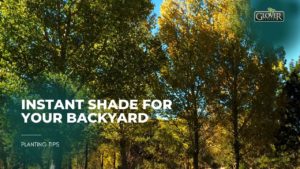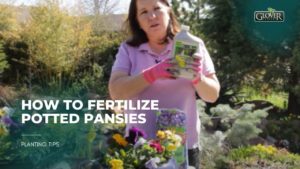When selecting plants for high elevation sites in Utah, there are several factors to consider. These include, but are not limited to a plant’s response to extreme cold temperatures, drying winter winds and heavy snow accumulation. Not all plants that are rated well for cold tolerance may not be suitable for your area for a variety of other reasons.
This list is recommended for homeowners and landscapers in Summit and Wasatch Counties, especially Park City, Heber, Midway, Kamas/Oakley, Echo and any other cities in mountainous, high-elevation areas.
Factors to consider for High Elevation Landscaping
USDA Zone
The USDA Plant Hardiness Zone Map is a measure of the cold hardiness for plants determined by the average annual extreme minimum temperature of a selected region. Zones range from 1 to 13; the lower the number, the colder the zone is. Zones are separated by 10 degree ranges and 5 degree half ranges. As of 2023, the Salt Lake Valley is designated a Zone 7b (5 to 10 degrees F avg. min. temp), while the Park City area ranges from a Zone 6a (-10 to -5 degrees F avg. min. temp) to a Zone 4b (-25 to -20 degrees F avg. min. temp).
Elevation
Generally, the higher the elevation the more extreme the weather conditions, such as snow accumulation or intense winds can be. Conversely, some plants prefer these cooler, higher elevations to drier, hotter conditions in low-lying valley areas.
Wind Exposure
More than just limb breakage and trunk damage, high winter winds are often the culprit of plants struggling and eventually dying all throughout the year. Evergreen plants, like needled conifers and broadleaf evergreens such as boxwoods and laurels transpire, or lose moisture through their foliage and need precipitation or watering in the winter. Wind can dry them out and cause fatal damage. Plants’ roots also need moisture to survive through winter, and winds can dry the soil to a point where plants can no longer take up moisture.
Snow Accumulation
Large amounts of snow in Utah’s mountain areas are typically associated with good skiing and runoff for drinking water. But when too much snow accumulates on trees and shrubs, it can cause branches and limbs to break off, exposing plants to frost and potential diseases or pests.
Deer Browsing
Sites in mountainous areas often deal with heavy deer or elk browsing, which can frustrate gardeners designs. Cross reference with our Deer-Resistant Plant list and get more tips on Protecting Plants from Deer.
Shrubs for High Elevation Landscapes
These shrubs are recommended based on decades of experience. Some of these plants are either native to the region or selected for good responses to the conditions described above.
Deciduous Shrubs
Almond, Flowering – Prunus glandulosa
Apache Plume – Fallugia paradoxa
Barberry – Berberis thunbergii
Buckthorn – Rhamnus spp.
Buffaloberry – Shepherdia argentea
Burning Bush – Euonymous alatus
Chokeberry – Aronia spp.
Cotoneaster – Cotoneaster spp.
Currant – Ribes spp.
Diervilla – Diervilla lonicera
Dogwood – Cornus spp.
Dogwood shrubs only. Trees are not recommended
Elderberry – Sambucus spp.
False/Ash Leaf Spiraea – Sorbaria sorbifolia
Fernbush – Chamaebataria millefolium
Filbert, Contorted – Corylus spp.
Forsythia – Forsythia spp.
May not bloom in long, extreme Winters
Fothergilla – Fothergilla spp.
Honeysuckle Bush – Lonicera spp.
Hydrangea – Smooth – Hydrangea arborescens
Leadplant – Amorpha canescens
Lilac – Syringa spp.
Mock Orange – Philadelphus spp.
Ninebark – Physocarpus spp.
Peashrub – Caragana spp.
Potentilla – Potentilla spp.
Privet – Ligustrum spp.
Rabbitbrush – Chrysothamnus spp.
Rose – Own Root var. – Rosa spp.
Meaning Roses that are grown on their own root and not grafted
Rose – Wood’s – Rosa woodsii
Sagebrush – Artemesia spp.
Sandcherry, Purple Leaf – Prunus cistena
Sandcherry, Western – Prunus besseyi
Serviceberry – Amalanchier spp.
Snowberry/Coralberry – Symphoricarpos spp.
Spiraea – Spiraea spp.
Sumac – Rhus spp.
Summersweet – Clethra alnifolia
Willow – Salix spp.
Viburnum – Viburnum spp.
Witch Hazel – Hamamelis spp.
Evergreen Shrubs
Boxwood – Buxus spp.
Must be Zone 4 cultivars and placed in protected locations
Bearberry/Kinnikinnick – Arctostaphylos uva-ursi
Dwarf Spruce* – Picea spp.
Including Alberta Spruce, Bird’s Nest Spruce, Globe Blue Spruce
Juniper – Juniperus spp.
Mountain Mahogany – Cercocarpus spp.
Mugo Pine* – Pinus mugo
Mugo Pines are not Deer-resistent
Oregon Grape – Berberis spp. (Mahonia)
Yew – Taxus spp.
Yucca, Adam’s Needle – Yucca filamentosa
Yucca, Soapweed – Yucca glauca
Trees for High Elevation Landscapes
Protect young trees from buck rubbing during rutting season (late October through January) if you’re in an area with deer traffic.
Deciduous Trees
Alder – Alnus spp.
Aspen* – Populus spp.
Birch – Betula spp.
Chokecherry* – Prunus virginiana
Cottonwood* – Populus spp.
Crabapple – Malus spp.
Elm – Ulmus spp.
Ginkgo – Ginkgo biloba
Hackberry – Celtis occidentalis
Hawthorn – Crataegus spp.
Honeylocust – Gleditsia triacanthos
Hornbeam – Carpinus spp.
Kentucky Coffeetree – Gymnocladus dioicus
Linden – Tilia spp.
Maple – Amur “Flame”* – Acer ginnala
Maple – Autumn Blaze – Acer x freemanii
Maple – Bigtooth* – Acer grandidentatum
Maple – Box Elder – Acer negundo
Maple – Hedge – Acer campestre
Maple – Tatarian – Acer tataricum
Mountain Ash – Sorbus spp.
Oak – Quercus spp.
Serviceberry* – Amalanchier spp.
Willow – Salix spp.
Tree Lilac – Syringa spp.
Evergreen Trees
Douglas Fir* – Pseudotsuga menziezii
Fir – Alpine* – Abies lasiocarpa
Fir – White* – Abies concolor
Juniper* – Juniperus spp.
Pine – Austrian* – Pinus nigra
Pine – Bosnian – Pinus heldreichii syn. leucodermis
Pine – Bristlecone* – Pinus aristata, P. longaeva
Pine – Limber* “Vanderwolf” – Pinus flexilis
Pine – Lodgepole* – Pinus contorta
Pine – Pinyon* – Pinus edulis, P. monophylla
Pine – Ponderosa – Pinus ponderosa
Pine – Scots* – Pinus sylvestris
Pine – Swiss Stone – Pinus cembra
Spruce – Black Hills* – Picea glauca
Spruce – Colorado/Blue* – Picea pungens
Spruce – Engelmann* – Picea engelmannii
Spruce – Norway* – Picea abies
Spruce – Oriental – Picea orientalis
Must be in protected locations (even if tree is Zone 3)
Spruce – White/Alberta – Picea glauca
Perennials for High Elevation Sites
Many popular perennials and flowers are perfectly capable of handling the cold and snow at high altitudes. Though, due to the shortened growing season these sites deal with, many of these perennials have delayed or shortened bloom seasons.
Full Sun Perennials
Achillea – Yarrow
Aconitum – Monkshood
Allium – Ornamental Onion
Aethionema – Persian Stonecress
Agastache – Hyssop, Hummingbird Mint
Alcea – Hollyhock
Alyssum – Madwort
Anaphalis margaritacea – Pearly Everlasting
Antennaria – Pussytoes
Aquilegia – Columbine
Armeria – Thrift
Artemisia – Wormwood
Asclepias – Milkweed
Aster – Aster
Aurinia – Basket of Gold
Baptisia – False Indigo
Berlandiera – Chocolate Flower
Callirhoe – Winecups
Campanula – Bellflower
Centaurea – Bachelor’s Button, Bluet
Centranthus – Jupiter’s Beard
Coreopsis – Tickseed
Dalea – Prairie Clover
Delphinium – Larkspur
Dianthus – Pinks, Sweet William
Digitalis – Foxglove
Echinacea – Coneflower
Erigonum – Buckwheat
Eupatorium – Joe Pye Weed
Gaillardia – Blanket Flower
Geranium – Cranesbill
Geum – Avens, Prairie Smoke
Gypsophila – Baby’s Breath
Hedysarum – Sweetvetch
Helenium – Sneezeweed
Heliopsis – False Sunflower, Ox-Eye Daisy
Hemerocalis – Daylily
Hibiscus moscheutos – Swamp/Rose Mallow
Hymenoxys – Sun Dancer Daisy
Iberis – Candytuft
Iliamna – Maple Mallow
Iris – Bearded, Flag, German
Leontopodium – Edelweiss
Leucanthemum – Shasta Daisy
Liatris – Blazing Star
Lilium – Lily
Linum – Blue Flax
Lupinus – Lupine
Lychnis – Maltese Cross, Rose Campion
Monarda – Bee Balm
Papaver – Poppy
Paeonia – Peony
Penstemon – Penstemon
Perovskia (Salvia) – Russian Sage
Phlox – Phlox
Physostegia – Obedient Plant
Platycodon – Balloon Flower
Nepeta – Catmint
Oenethera – Evening Primrose
Ratibida – Mexican Hat
Rudbeckia – Black-Eyed Susan
Salvia nemrosa – Meadow Sage
Saponaria – Soapwort
Scabiosa – Pincushion
Solidago – Goldenrod
Sphaeralcea – Globe Mallow
Stachys – Lamb’s Ear
Thermopsis – Golden Banner
Tradescantia – Spiderwort
Shade/Partial Sun Perennials
Alchemilla – Lady’s Mantle
Aruncus – Goat’s Beard
Astillbe – False Goat’s Beard, False Spiraea
Bellis – English Daisy
Bergenia – Pigsqueak
Brunnera – Siberian Bugloss, ‘Jack Frost’
Dicentra – Bleeding Heart
Doronicum – Leopard’s Bane
Helleborus – Hellebore, Lenten Rose
Heuchera – Coral Bells
Hosta – Hosta, Plantain Lily
Polemonium – Jacob’s Ladder
Polygonatum – Solomon’s Seal
Pulmonaria – Lungwort
Thalictrum – Meadow Rue
Trollis – Globe Flower
Viola – Violet
Ferns
Christmas Fern – Polystichum acrostichoides
Lady Fern – Athyrium filix-femina
Male Fern – Dryopteris filix-mas
Ostrich Fern – Matteuccia struthiopteris
Painted Fern – Athyrium niponicum
Royal Fern – Osmunda regalis
Sword Fern – Polystichum munitum
Groundcover for High Elevation Sites
Arabis – Rock Cress
Ajuga – Bugleweed
Arenaria – Sandwort
Arctostaphylos uva-ursi – Bearberry/Kinnikinnick
Aubrieta – False Rock Cress
Cerastium – Snow-in-summer
Cornus canadensis – Bunchberry, Creeping Dogwood
Galium odoratum – Sweet Woodruff
Lamium – Dead Nettle
Lysimachia – Creeping Jenny
Paxistima spp. – Mountain Lover
Phlox subulata – Creeping Phlox
Sedum – Stonecrop
Sempervivum – Hens & Chicks
Thymus – Creeping Thyme
Veronica – Creeping Speedwell
Vinca major, Vinca minor– Periwinkle
Grasses for Park City and High Elevations
Acnatherum – Indian Ricegrass
Andropogon – Big Bluestem
Bouteloua – Grama Grass, ‘Blonde Ambition’
Calamagrostis – Feather Reed Grass, ‘Karl Foerster’
Chasmanthium – Northern Sea Oats
Festuca – Fescue
Heliotrichon – Blue Oat Grass
Leymus – Wild Rye Grass
Liriope – Lilyturf
Panicum – Switchgrass
Schizachyrium – Little Bluestem
Sorghastrum – Indian Grass
Sporobolus – Prairie Dropseed, Sacaton Grass

